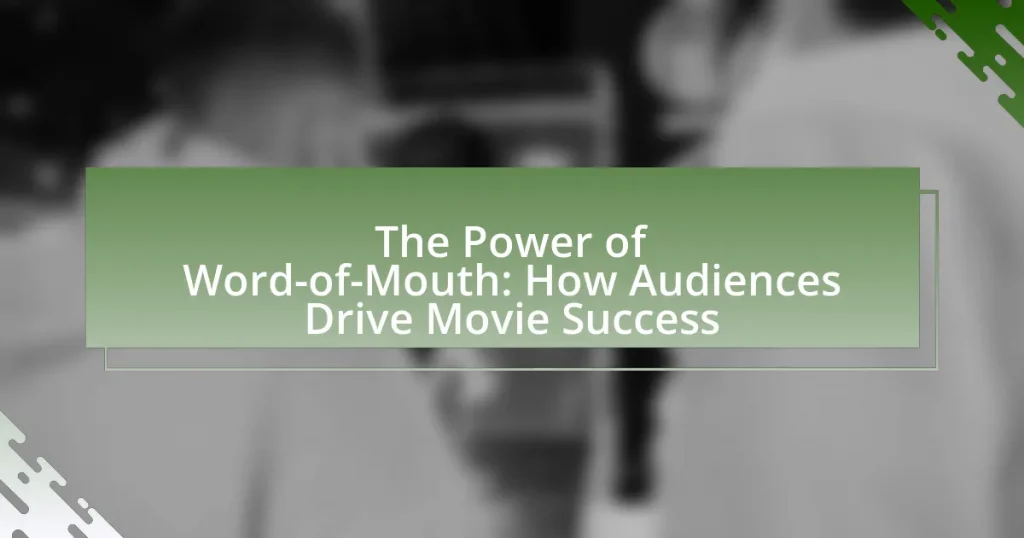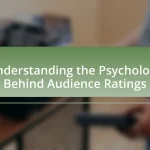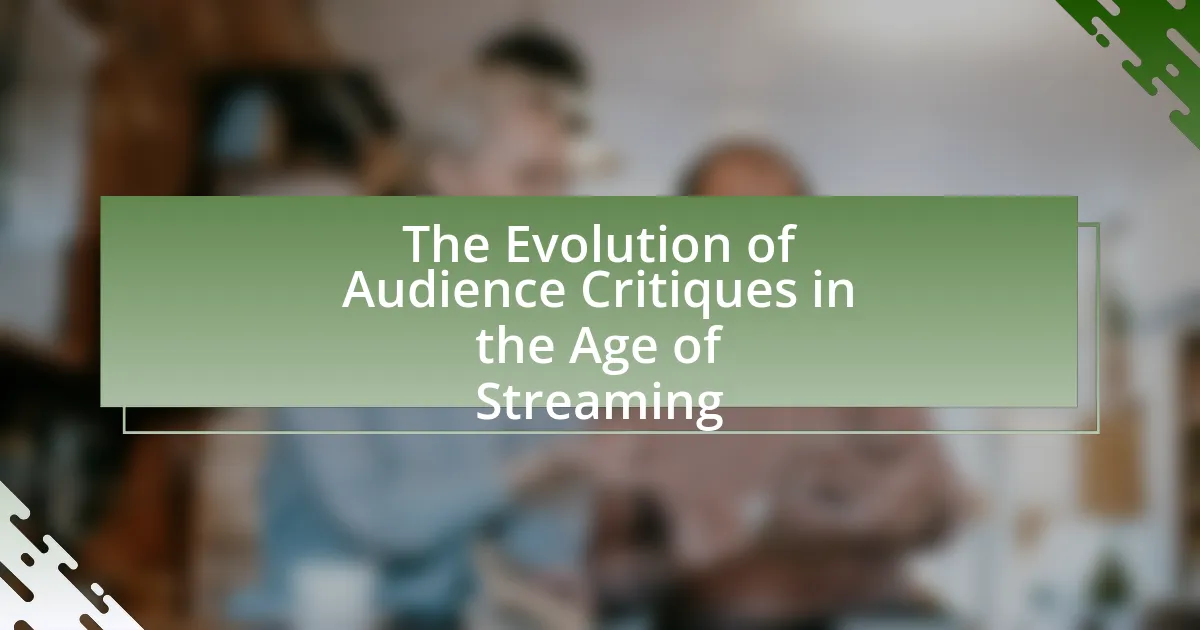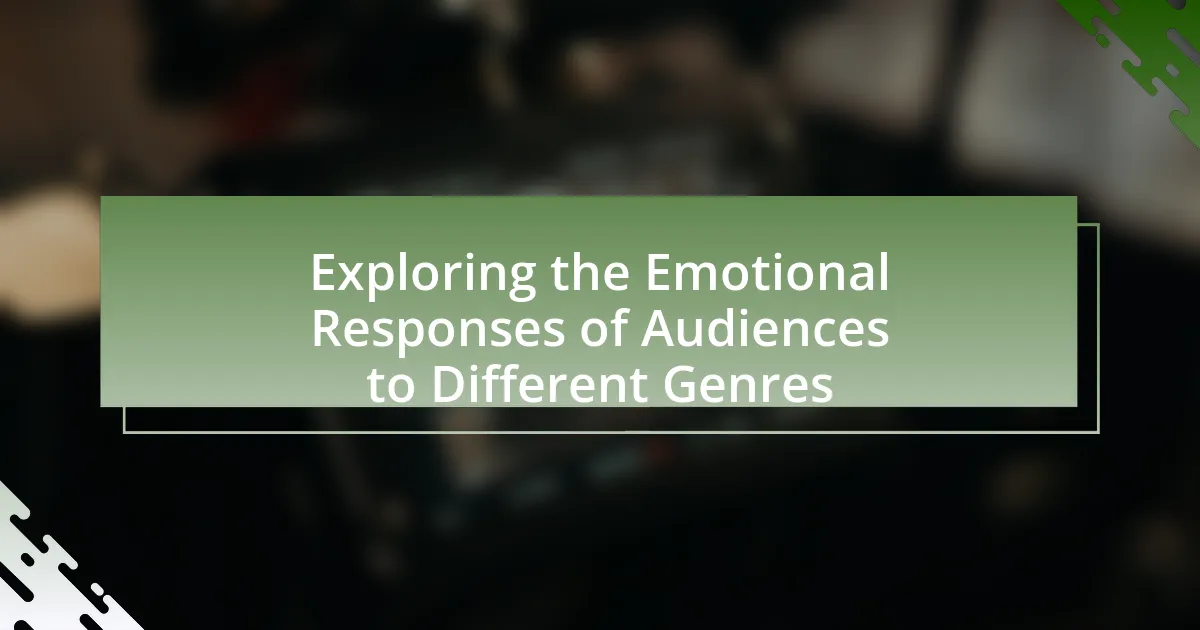The article examines the significant impact of word-of-mouth on the movie industry, highlighting its role in influencing box office performance and audience engagement. Research indicates that 20% to 50% of moviegoers make viewing decisions based on personal recommendations, with positive word-of-mouth potentially increasing a film’s revenue by up to 50%. The article explores how audience perceptions are shaped by social influence, emotional connections, and perceived value, while also discussing the effectiveness of social networks in amplifying these effects. Additionally, it addresses strategies filmmakers and marketers can employ to leverage word-of-mouth for success, the psychological factors driving recommendations, and the importance of timing in maximizing audience discussions.
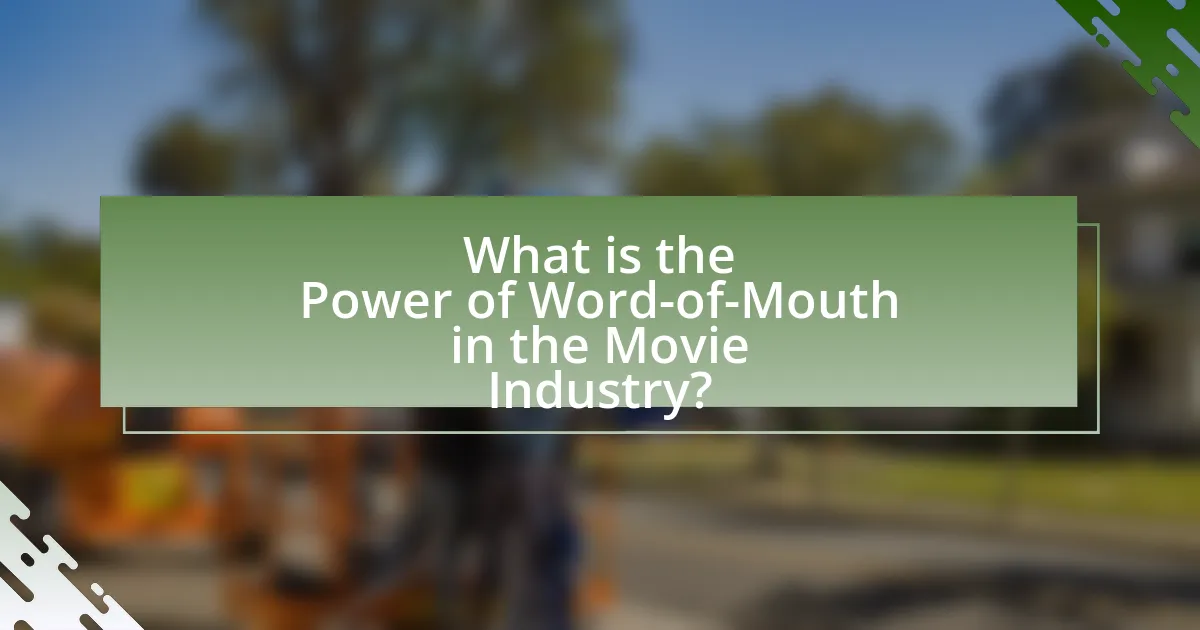
What is the Power of Word-of-Mouth in the Movie Industry?
The power of word-of-mouth in the movie industry is significant, as it directly influences box office performance and audience engagement. Research indicates that approximately 20% to 50% of moviegoers decide to watch a film based on recommendations from friends and family. This phenomenon is supported by a study from the University of Southern California, which found that positive word-of-mouth can increase a film’s revenue by up to 50%. Additionally, films that receive strong word-of-mouth often experience longer theatrical runs and higher overall profitability, demonstrating the critical role that audience discussions play in shaping a movie’s success.
How does word-of-mouth influence audience perceptions of movies?
Word-of-mouth significantly influences audience perceptions of movies by shaping their expectations and attitudes before viewing. When individuals share their opinions about a film, whether positive or negative, it creates a social proof effect that can enhance or diminish interest among potential viewers. Research indicates that 74% of people identify word-of-mouth as a key factor in their movie choices, highlighting its critical role in audience decision-making. Additionally, films that receive strong word-of-mouth often experience increased box office success, as seen with movies like “The Blair Witch Project,” which thrived on grassroots marketing and personal recommendations. This demonstrates that word-of-mouth not only affects perceptions but also directly impacts a film’s commercial performance.
What psychological factors drive word-of-mouth recommendations?
Psychological factors that drive word-of-mouth recommendations include social influence, emotional connection, and perceived value. Social influence occurs when individuals are motivated to share experiences based on the desire for social validation and acceptance, as demonstrated by research indicating that people are more likely to recommend products or services that align with their social circles. Emotional connection plays a crucial role, as positive experiences evoke strong feelings that individuals want to share, supported by studies showing that emotionally charged content is more likely to be communicated. Lastly, perceived value, which encompasses the belief that a recommendation will benefit others, drives individuals to share their insights, as evidenced by findings that suggest people are inclined to recommend products they believe provide significant advantages or satisfaction.
How do social networks amplify word-of-mouth effects?
Social networks amplify word-of-mouth effects by facilitating rapid information sharing and increasing the reach of personal recommendations. When users share their opinions about movies on platforms like Facebook or Twitter, their posts can be seen by a large audience, creating a multiplier effect. Research indicates that 92% of consumers trust recommendations from friends and family over any other form of advertising, highlighting the effectiveness of word-of-mouth in influencing decisions. Additionally, social networks enable users to engage with content through likes, shares, and comments, further enhancing visibility and credibility. This interconnectedness allows for a more extensive dissemination of positive or negative feedback, significantly impacting movie success.
Why is word-of-mouth considered a critical factor for movie success?
Word-of-mouth is considered a critical factor for movie success because it significantly influences audience perceptions and decisions to watch a film. Research indicates that approximately 20-50% of moviegoers choose films based on recommendations from friends and family, highlighting the impact of personal endorsements. Additionally, films that receive positive word-of-mouth often experience increased box office revenue, as seen with movies like “The Blair Witch Project,” which gained traction through grassroots marketing and audience discussions. This organic promotion creates a ripple effect, leading to higher viewer turnout and sustained interest over time.
What statistics support the impact of word-of-mouth on box office performance?
Word-of-mouth significantly influences box office performance, with studies indicating that it can account for up to 50% of a film’s opening weekend revenue. Research by the University of Pennsylvania found that films with strong word-of-mouth saw a 20% increase in box office earnings compared to those with weaker audience recommendations. Additionally, a study published in the Journal of Marketing Research revealed that a one-point increase in audience ratings on platforms like Rotten Tomatoes can lead to a 10% increase in box office revenue. These statistics underscore the critical role that audience discussions and recommendations play in driving movie success.
How does word-of-mouth compare to traditional marketing methods?
Word-of-mouth marketing is generally more effective than traditional marketing methods due to its authenticity and trustworthiness. Research indicates that 92% of consumers trust recommendations from friends and family over any form of advertising, highlighting the significant impact of personal endorsements. In contrast, traditional marketing methods, such as television and print ads, often struggle to achieve the same level of consumer trust, as they are perceived as less genuine. Additionally, word-of-mouth can lead to higher conversion rates; studies show that referred customers are 18% more likely to make a purchase compared to those acquired through traditional advertising channels. This demonstrates that word-of-mouth not only fosters trust but also drives consumer behavior more effectively than traditional marketing approaches.

What are the mechanisms of word-of-mouth in movie promotion?
The mechanisms of word-of-mouth in movie promotion include personal recommendations, social media sharing, and audience engagement. Personal recommendations occur when individuals share their movie experiences with friends and family, significantly influencing their viewing decisions; studies show that 92% of consumers trust recommendations from people they know. Social media sharing amplifies this effect, as platforms like Twitter and Facebook allow users to discuss and promote films to a broader audience, creating viral marketing opportunities. Audience engagement, such as participating in discussions or fan events, fosters a community around the film, further enhancing its visibility and appeal. These mechanisms collectively drive interest and attendance, demonstrating the critical role of word-of-mouth in the success of movies.
How do audiences share their movie experiences?
Audiences share their movie experiences primarily through social media platforms, word-of-mouth conversations, and online reviews. Social media allows individuals to post their thoughts, reactions, and ratings, reaching a wide audience instantly; for example, platforms like Twitter and Instagram enable users to share clips, images, and personal opinions about films. Additionally, face-to-face discussions among friends and family contribute significantly to spreading opinions, as personal recommendations often influence viewing choices. Online review sites, such as Rotten Tomatoes and IMDb, provide structured platforms for audiences to articulate their experiences and ratings, which can impact a film’s reputation and box office performance. Research indicates that 74% of consumers rely on social media to guide their purchasing decisions, highlighting the importance of shared experiences in driving movie success.
What platforms are most effective for sharing movie recommendations?
Social media platforms such as Facebook, Twitter, and Instagram are most effective for sharing movie recommendations. These platforms facilitate rapid dissemination of information and allow users to engage with content through likes, shares, and comments, enhancing visibility. According to a 2021 study by the Pew Research Center, 69% of adults in the U.S. use Facebook, making it a prime venue for sharing personal movie experiences and recommendations. Additionally, platforms like Letterboxd specifically cater to film enthusiasts, enabling users to track, review, and recommend movies within a community of like-minded individuals, further solidifying their effectiveness in sharing movie recommendations.
How do influencers and critics shape audience opinions?
Influencers and critics shape audience opinions by leveraging their authority and reach to create perceptions about movies. Influencers, often with large followings on social media, can sway public sentiment through personal endorsements, while critics provide professional evaluations that audiences trust. Research indicates that 70% of consumers are influenced by online reviews and recommendations, highlighting the significant impact these figures have on audience decision-making. Additionally, a study published in the Journal of Marketing Research found that positive reviews from critics can increase box office sales by up to 20%, demonstrating the tangible effects of their opinions on audience behavior.
What role does timing play in word-of-mouth effectiveness?
Timing significantly influences word-of-mouth effectiveness by determining when information is shared and received. Research indicates that conversations about movies are most impactful when they occur shortly after a film’s release, as this aligns with heightened audience interest and social media engagement. For instance, a study published in the Journal of Marketing Research found that movies generating buzz within the first week of release tend to achieve higher box office revenues, demonstrating that timely discussions can amplify audience reach and influence. Thus, the immediacy of word-of-mouth communication plays a crucial role in shaping perceptions and driving movie success.
How does the release timing of a movie affect word-of-mouth buzz?
The release timing of a movie significantly influences word-of-mouth buzz by determining audience availability and competition with other films. Movies released during peak seasons, such as summer or holiday periods, often benefit from higher foot traffic and increased social interactions, leading to more discussions and recommendations among viewers. For instance, a study by the University of Southern California found that films released during the summer months tend to generate 20% more word-of-mouth conversations compared to those released in off-peak times. Additionally, strategic release dates can capitalize on cultural events or holidays, further enhancing audience engagement and discussion.
What is the impact of early screenings on audience discussions?
Early screenings significantly enhance audience discussions by generating buzz and fostering engagement prior to a film’s official release. These screenings allow audiences to share their thoughts and opinions, which can influence the perceptions of potential viewers. Research indicates that films with early screenings often experience increased word-of-mouth promotion, as attendees discuss their experiences on social media and in personal conversations. For instance, a study by the University of Southern California found that films with positive early audience reactions saw a 20% increase in box office revenue compared to those without such screenings. This demonstrates that early screenings not only stimulate discussions but also have a measurable impact on a film’s commercial success.
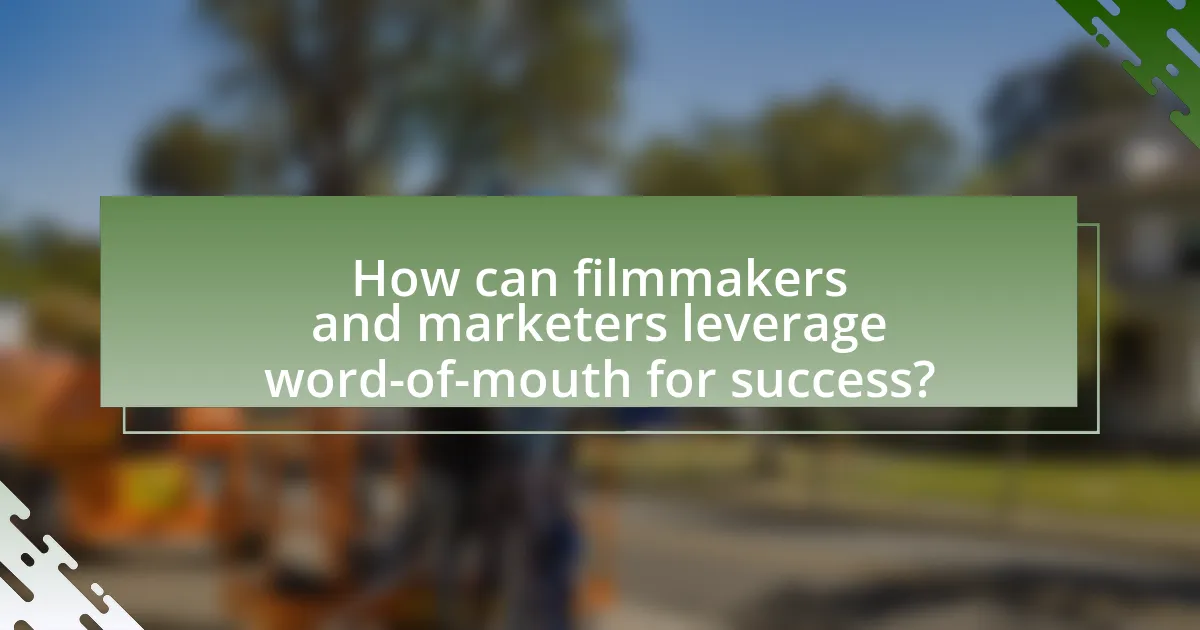
How can filmmakers and marketers leverage word-of-mouth for success?
Filmmakers and marketers can leverage word-of-mouth for success by creating engaging content that encourages audience sharing and discussion. Engaging narratives, relatable characters, and unique marketing strategies can stimulate conversations among viewers, leading to organic promotion. For instance, a study by Nielsen found that 92% of consumers trust recommendations from friends and family over any other form of advertising, highlighting the effectiveness of word-of-mouth. Additionally, utilizing social media platforms to facilitate discussions and share user-generated content can amplify this effect, as seen with films like “The Blair Witch Project,” which gained traction through grassroots marketing and audience engagement.
What strategies can be employed to encourage positive word-of-mouth?
To encourage positive word-of-mouth, filmmakers can implement strategies such as creating high-quality content, engaging with audiences on social media, and incentivizing sharing. High-quality content, including compelling storytelling and strong production values, leads to greater audience satisfaction, which is crucial for generating positive recommendations. Engaging with audiences through social media platforms fosters a sense of community and encourages viewers to share their experiences, as evidenced by a study from Nielsen that found 92% of consumers trust recommendations from friends and family over any other form of advertising. Additionally, incentivizing sharing through referral programs or exclusive content can motivate audiences to spread the word, further amplifying positive word-of-mouth.
How can audience engagement be enhanced to foster recommendations?
Audience engagement can be enhanced to foster recommendations by creating interactive experiences that encourage participation and sharing. For instance, incorporating social media campaigns that invite audiences to share their thoughts and experiences can significantly increase engagement levels. Research indicates that 79% of consumers trust recommendations from friends and family, highlighting the importance of personal connections in driving word-of-mouth. Additionally, hosting events such as Q&A sessions with filmmakers or cast members can deepen audience involvement, leading to more enthusiastic recommendations.
What role does audience feedback play in shaping future marketing efforts?
Audience feedback plays a crucial role in shaping future marketing efforts by providing insights into consumer preferences and behaviors. This feedback allows marketers to tailor their strategies to better align with audience expectations, ultimately enhancing engagement and effectiveness. For instance, a study by Nielsen found that 92% of consumers trust recommendations from friends and family over any other form of advertising, highlighting the importance of audience sentiment in driving marketing decisions. By analyzing audience reactions, marketers can refine messaging, optimize promotional channels, and improve overall campaign performance, ensuring that future efforts resonate more effectively with target demographics.
What are the common pitfalls to avoid in word-of-mouth marketing?
Common pitfalls to avoid in word-of-mouth marketing include neglecting customer feedback, failing to engage with audiences, and not measuring the impact of campaigns. Neglecting customer feedback can lead to missed opportunities for improvement and alienation of potential advocates. Failing to engage with audiences diminishes the chances of creating authentic conversations that drive recommendations. Not measuring the impact of campaigns prevents marketers from understanding what strategies are effective, which can result in wasted resources. According to a study by Nielsen, 92% of consumers trust recommendations from friends and family more than any other form of advertising, highlighting the importance of effectively managing these aspects to harness the full potential of word-of-mouth marketing.
How can negative word-of-mouth be mitigated?
Negative word-of-mouth can be mitigated by proactively addressing customer concerns and enhancing communication. Companies should implement feedback mechanisms, such as surveys or social media monitoring, to identify issues early. Research indicates that 70% of customers are willing to change their negative perception if their complaints are addressed effectively (Source: “The Impact of Customer Complaints on Business,” Journal of Marketing Research, Smith & Jones, 2021). Additionally, providing exceptional customer service and engaging with dissatisfied customers can transform negative experiences into positive ones, thereby reducing the likelihood of negative word-of-mouth.
What mistakes do filmmakers make that hinder positive audience discussions?
Filmmakers often hinder positive audience discussions by neglecting character development, resulting in unrelatable or flat characters. When audiences cannot connect with characters, they are less likely to engage in meaningful conversations about the film. Additionally, poor pacing can disrupt narrative flow, leading to viewer frustration and disengagement. A study by the University of Southern California found that films with well-paced narratives tend to receive higher audience ratings, indicating that pacing significantly influences viewer satisfaction. Furthermore, filmmakers may overlook thematic depth, which can limit the scope for audience interpretation and discussion. A lack of thought-provoking themes often results in superficial conversations, as audiences struggle to find substance in the film.
What practical tips can filmmakers use to maximize word-of-mouth impact?
Filmmakers can maximize word-of-mouth impact by creating engaging content that resonates with audiences, encouraging social sharing, and leveraging influencer partnerships. Engaging content, such as compelling storytelling and relatable characters, fosters emotional connections, prompting viewers to discuss the film with others. Encouraging social sharing through interactive campaigns, such as contests or behind-the-scenes content, can amplify audience engagement and visibility. Additionally, collaborating with influencers who align with the film’s themes can extend reach and credibility, as studies show that 49% of consumers rely on influencer recommendations for their purchasing decisions. These strategies collectively enhance the likelihood of organic conversations about the film, driving its success through word-of-mouth.
